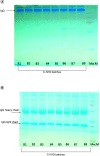Production of hyperimmune anti-SARS-CoV-2 intravenous immunoglobulin from pooled COVID-19 convalescent plasma
- PMID: 33557591
- PMCID: PMC7871744
- DOI: 10.2217/imt-2020-0263
Production of hyperimmune anti-SARS-CoV-2 intravenous immunoglobulin from pooled COVID-19 convalescent plasma
Abstract
Background: This study assesses the feasibility of producing hyperimmune anti-COVID-19 intravenously administrable immunoglobulin (C-IVIG) from pooled convalescent plasma (PCP) to provide a safe and effective passive immunization treatment option for COVID-19. Materials & methods: PCP was fractionated by modified caprylic acid precipitation followed by ultrafiltration/diafiltration to produce hyperimmune C-IVIG. Results: In C-IVIG, the mean SARS-CoV-2 antibody level was found to be threefold (104 ± 30 cut-off index) that of the PCP (36 ± 8.5 cut-off index) and mean protein concentration was found to be 46 ± 3.7 g/l, comprised of 89.5% immunoglobulins. Conclusion: The current method of producing C-IVIG is feasible as it uses locally available PCP and simpler technology and yields a high titer of SARS-CoV-2 antibody. The safety and efficacy of C-IVIG will be evaluated in a registered clinical trial (NCT04521309).
Keywords: SARS-CoV-2; anti-COVID-19 IVIG; caprylic acid; convalescent plasma; diafiltration; immunotherapy; intravenous immunoglobulins; passive immunization; pooled plasma; ultrafiltration.
Figures




References
-
- World Health Organization. Coronavirus disease (COVID-19) pandemic (2020). www.who.int/emergencies/diseases/novel-coronavirus-2019
-
- Fernandes N Economic effects of coronavirus outbreak (COVID-19) on the world economy. IESE Business School Working Paper No. WP-1240-E. (2020) (Epub ahead of print)
Publication types
MeSH terms
Substances
Associated data
Grants and funding
LinkOut - more resources
Full Text Sources
Other Literature Sources
Medical
Miscellaneous
